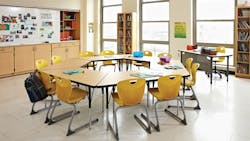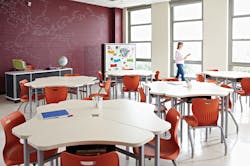As springtime approaches, people begin to think about ways to get a fresh start. What if that same concept were applied to education facilities? What kinds of updates would teachers and students have for schools? Over the course of a school year, many may notice areas around their schools that need updating. Whether considering immediate improvements or scoping out plans for the coming school year, schools and universities have many opportunities to create updated learning environments.
School administrators should keep in mind a number of education trends when considering updates. From the basics, such as updating furniture to accommodate the latest technology, to larger design trends, such as creating more collaborative classrooms, these trends empower administrators and facility managers to create a learning environment that’s more sustainable, productive and healthful. Several strategies can help institutions upgrade classrooms while still adhering to budgetary restrictions.
Adapt to Changing Technology
Classroom technology has changed greatly over the last decade. Some schools have transitioned from chalkboards and easels to interactive whiteboards and tablet computers. Students are benefitting from innovative programs powered by new technological devices, but it’s likely that the furniture and overall classroom environments have not been updated to keep up with these advances.
For example, in many schools, the technology workstations that students use were made to accommodate desktop computers and other outdated technologies that require multiple cables. Laptops and tablets don’t require multiple cables, so workstations need only to give students a way to charge their devices and ensure continual usage.
Similarly, many desks were designed for large monitors and tower computers. Using a laptop at these older workstations may lead to poor posture and strained vision, so it’s crucial that desks and workstations are right-sized for the technology that schools are providing to students.
As technology becomes more prevalent, lighting schemes in classrooms are evolving. By dimming lights and adjusting shades and blinds, schools can eliminate glare on computer screens, ensure visibility of interactive whiteboards, and reduce eye strain among students and faculty.
Be Flexible
Interactive whiteboards, laptops, tablets and other technologies help create a more engaging learning experience. However, this experience often is stifled by stationary furniture that confines students to one area of the classroom. With mobile furniture, arranged to support open, intuitive traffic patterns, schools can make the most of interactive whiteboard investments to ensure accessibility and create an environment more conducive to collaboration.
Classroom furniture trends also emphasize flexibility and the ability to rearrange classrooms. Using mobile furniture is crucial for creating multipurpose classrooms, so many schools have acquired lightweight furniture that can be moved smoothly throughout a classroom. Because students can quickly and easily move from clustered work areas back into rows for independent working, mobile furniture is a wise investment for a modern classroom.
Many schools are installing demountable walls, and manufacturers have responded with lightweight, movable wall offerings.
Maintaining Floors
In high-traffic areas, the wear on flooring is significant, especially where mobile furniture is used. To reduce damage, labor and costs associated with clearing and cleaning floor areas, facility managers should consider stacking and nesting techniques. Chairs and other bulky furniture can be stacked or nested on carts and moved with little difficulty. Cleaning floors and rearranging furniture becomes less strenuous.
It’s also important to install casters and glides, appropriate for the flooring surface, on furniture and equipment. Hard glides are most effective on soft surfaces such as carpet; hard surfaces such as vinyl and vinyl composition tile (VCT) are best preserved with hard felt or specially designed dual-composition glides.
Creating New Learning Environments
In addition to updating conventional learning environments, many schools are looking to facilitate informal learning and extend collaboration beyond traditional classroom walls.
Selecting the right furniture can help create “casual tasking areas” where students and faculty can kick back, interact and collaborate. These areas help promote an open environment beyond a formal classroom setting, and teachers and students have a place to interact in a less-structured and more personal way.
Incorporating Sustainability
Promoting practices and products that are better for the environment remains a priority for many facility managers. New trends in technology, furniture and appliances present opportunities to incorporate sustainable programs into schools in a variety of ways.
Improving indoor air quality a goal for schools striving to create a healthful environment and embrace Leadership in Energy and Environmental Design (LEED) principles. To achieve those environmental goals, institutions must select furniture that doesn’t pollute the air by off-gassing formaldehyde or other irritants.
When it comes to the interior space, facility managers are seeing that furniture made from recycled, renewable and sustainable materials can make buildings more healthful and productive.
Design plays a key role—to create a truly eco-conscious classroom and school, sustainable furniture should be part of an environmentally oriented strategy. Environmentally preferable pieces of furniture can help prioritize student health and enable schools to achieve relevant certifications and standards.
The demand for recycled and environmentally preferable products isn’t new, but the notion of sustainability is evolving and becoming more holistic, i.e., integrated across all areas of a facility and spanning all aspects of a given product. Facility managers who recognize this trend and work with manufacturers, distributors and furniture dealers will be positioned better to meet sustainability demands and LEED standards as they evolve.
Some education administrators may dream of starting from scratch and walking into a new facility, but for most, that is a fantasy. Still, updating furniture to accommodate changing classroom environments can help make students and faculty more productive and healthy, and will ultimately create a more positive and collaborative environment.
Michael is vice president and general manager of Business Interiors by Staples.

